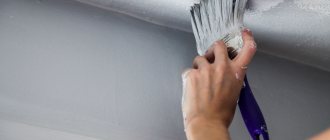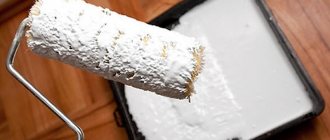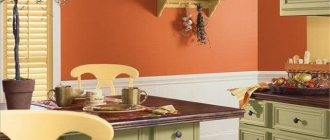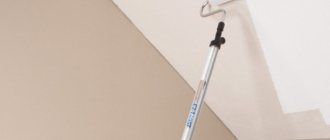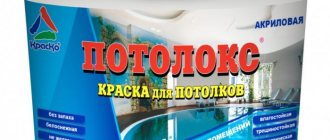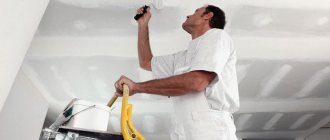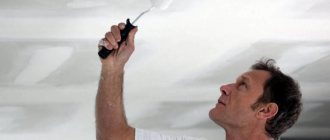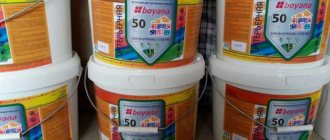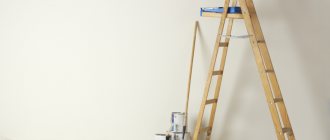Repair work includes many stages of surface finishing; a special highlight is finishing the ceiling. There are many materials on sale to cover the ceiling. But whitewashing the ceiling with a water-based composition does not lose its position and is chosen by many. This is due to the simplicity of the work and the good results obtained. How to whitewash a ceiling with water-based paint correctly will be discussed below.
Advantages of water-based paint
Among similar products, water emulsion has several positive properties. They are what make it so popular when finishing ceiling surfaces. The following advantages stand out:
- No unpleasant odor;
- Fast drying speed, the process will take only a couple of hours;
- Work safety;
- Pleasant decorative effect;
- Good compatibility with many materials, except metal products;
- Ease of care;
- It is easy to clean tools and skin after using the composition.
Fast drying speed, the process will only take a couple of hours.
Types of material
In order for whitewashing with water-based paint to be successful with your own hands, you need to choose the appropriate composition. There are several types of products on the market, they have different characteristics:
- Mineral look. The composition contains cement or lime. It is of low quality, so this coating will not last long. It is used more often for buildings made of brick and concrete that are not residential. Cheap option;
- Silicate, based on liquid glass. Highly resistant, this finish will last 20 years or even more. But does not tolerate exposure to moisture;
- Acrylic, the base consists of acrylic resin mixed with water, they are odorless and give the surface a beautiful decorative appearance. Resistant to mechanical stress, can be cleaned using a soap solution. It is vapor-tight, so the surface must dry before application;
- Silicone, the most expensive and high-quality type. Unlike the previous type, it allows steam to pass through, so it can be applied to a surface that is not completely dry. Can be washed.
The compositions can have a glossy, matte, semi-matte effect. The glossy version is easy to clean, but cannot hide surface imperfections; the matte version is difficult to clean, but at the same time they cover minor imperfections.
In order for whitewashing with water-based paint to be successful with your own hands, you need to choose the appropriate composition.
Preparation of working solution
The calculation of the required materials is carried out based on the ceiling area in all rooms that need to be whitewashed. They are calculated by multiplying the length and width of each room that needs to be whitewashed and adding the result.
Chalk solution
The chalk solution is prepared from fine powder intended specifically for whitewashing. The table shows the solution recipe and the number of components required for whitewashing 10 m² of ceiling area.
Chalk whitewash solution
Table. Chalk solution for whitewashing.
| №№ | Component | Quantity |
| 1 | Dry chalk | 2.3 kg |
| 2 | Water | 4 l |
| 3 | Wood glue or PVA | 90 g |
| 4 | Laundry soap | 60 g |
| 5 | Blue, powder | 17 g |
Preparation of chalk solution.
- Take the required amount of warm water and pour it into a plastic or enamel container of sufficient volume.
- Glue is dissolved in water.
- Add pre-grated or knife-cut soap.
- Pour in the calculated amount of chalk and mix thoroughly by hand or with a construction mixer.
- Add blue to give whiteness or tint to create the desired shade, mix again.
- Strain through two or three layers of gauze or nylon stocking to remove lumps and foreign particles.
Preparation of chalk solution for whitewashing the ceiling
After filtering, the solution is ready for use. It is better to use it immediately - during storage it settles and will require repeated mixing. The solution can also be prepared from chalk paste, packaged in jars; it is sold in hardware stores. In this case, the solution is prepared following the instructions on the package.
Lime solution
If quicklime is used, it must be slaked first.
- It is better to carry out all work on slaking lime outdoors or indoors, which is not afraid of splashes, steam, or high temperature.
- Be sure to wear safety glasses, gloves, and protective clothing or an apron to protect against hot splashes and steam.
- Lump or powder quicklime is placed in a stainless steel container. Fill it with cold water in an equal amount to obtain fluff; if you need to get lime milk, then take 1.5-2 times more water.
- The quenching reaction is accompanied by the release of a large amount of heat, and the solution begins to steam, boil and heats up to a temperature of 150 degrees. Some of the water may boil away; when a crust forms, add a small amount of water. The lime is mixed during the slaking process using a wooden stick.
- Depending on the type, the lime slaking time can range from 10 to 25 minutes. This information is usually indicated on the packaging. The lime must be completely quenched, otherwise its covering power will be insufficient during whitewashing.
- The lime must be kept for at least a day, or better yet, two or three days. During this time, it will be completely extinguished and will dissolve better when preparing the whitewash.
Ready fluff lime is diluted according to the recipe given in the table. The consumption in the table is indicated for 10 m².
Table. Lime mortar for whitewashing.
| №№ | Component | Quantity |
| 1 | Slaked lime | 2 kg |
| 2 | Water | 4-6 l |
| 3 | Table salt | 50 g (2 tablespoons) |
| 4 | Color or blue | 20-50 g |
Preparation of lime mortar.
- Slaked lime is poured into an enameled or galvanized bucket. It is not recommended to use plastic - if the lime has not been completely slaked, a violent reaction may begin with the release of heat.
- Add table salt or powdered coloring, gradually pour in cold water, stirring gently, and dilute the lime to the consistency of liquid sour cream.
- After a few minutes, a reaction will begin in which the solution can heat up to a high temperature. In this case, the water may boil and release a large amount of steam, so it is better to do this outdoors or on the balcony.
- Bring the solution to the desired consistency by adding water - it should be quite thick. Check the consistency this way: dip a smooth metal object, such as a spatula or knife, into the solution and let the solution drain. The metal should then remain completely painted.
- Cool and filter the solution, after which you can begin whitewashing.
Unlike chalk mortar, lime mortar only benefits from long-term storage, it becomes more uniform and exhibits its covering ability better. Therefore, you can prepare a solution for several stages of whitewashing at once. When using ready-made lime milk, water is added to it until the desired consistency is achieved; no reaction with heating occurs.
How to choose water-based paint
To choose a good and suitable composition, you can follow the tips listed below; they will help you find the best option among the many paints:
- If you decide to paint the ceiling white, then a composition with titanium dioxide will work well, the coating will be perfectly white;
- To produce water-based emulsions, expensive foreign materials are used, so the cost is high. If you come across a cheap type on sale, then low-quality ingredients were probably used for production, or it is an expired product. Such a price should arouse suspicion;
- To make it easier to distinguish the scope of application of products, material marking is used; if there is a number 1, then this type is suitable for exterior finishing; to whitewash the ceiling, choose the VD2 marking.
The average consumption is indicated on the packaging, but if the solution is tinted, you need to take extra paint, the consumption will increase. It is important to buy the correct quantity of the product, because it is difficult to create the same shade of the solution again.
Consumption may increase depending on the surface material. It is imperative to study the consumption data indicated by the manufacturer, because cheaper options often require more consumption, so there may not be any savings.
This product does not tolerate frost and heat well, so buying them on the street is undesirable.
The average consumption is indicated on the packaging, but if the solution is tinted, you need to take extra paint, the consumption will increase.
Some subtleties of choosing an emulsion
The variety of paints is enormous.
When choosing, it is worth considering the condition of the surface - it is better to paint rough ones with matte compounds, but there will be difficulties when washing. The glossy, special white coating reflects light well, so it can be recommended for ceilings in rooms with insufficient lighting.
For the kitchen, bathroom, laundry room, swimming pool, the requirements of low abrasion, the ability to wash with household chemicals, and vapor permeability come to the fore - silicone paints are the best choice.
Whitewashing the ceiling of a non-residential, rarely visited, but dry room can be done with a mineral emulsion; for damp ones that require periodic washing, acrylic and silicone paints are suitable.
Preparing the necessary tools for whitewashing
The tools you choose can affect the speed of work and the results obtained. To carry out the painting itself, you will need one of the following tools:
- A roller is a convenient option; you can quickly cover the ceiling and walls with it;
- Brush. When processing is carried out with a brush, streaks may remain on the surface, making it difficult to hide the strokes. It is advisable to paint only corners and hard-to-reach places with it;
- Spray gun. The work will proceed at a fast pace, there will be no streaks, and the coating will be uniform. But it is important to protect nearby surfaces, because splashes can get on them and in your eyes.
For other stages you will need to prepare:
- Sandpaper;
- Masking tape;
- Polyethylene film;
- Putty knife;
- Cuvette;
- Stepladder.
The tools you choose can affect the speed of work and the results obtained.
Is it possible to paint the ceiling over old whitewash?
Before painting the ceiling over whitewash, a thorough cleaning of the surface and complete removal of old material is required, but in some cases this step can be skipped. If the previous layer holds up well, does not crumble, and there are no traces of rust or mold, potholes, chips or other defects on the surface, then careful preparation may not be necessary. If you have at least one of the above problems, it is better not to paint the ceiling over whitewash.
Which roller to paint with?
To make the job easier, you should choose the right tool. According to experts, a roller is best suited for painting ceilings with water-based paint. At the same time, they note that the pile should be long and natural, the handle should be elongated.
What rollers are used:
- Fur or velor, has good paint retention, but is more expensive than synthetic analogues;
- Painting, impregnates the paint; you need to lower the roller into the ditch less often, but if you press hard, the substance can flow out;
- With long pile, a metal thread is used inside, making the tool more reliable and more expensive;
- With relief, we can use it to create patterns on the surface, if the designer has a similar idea to decorate the ceiling.
For large areas, the best option would be to use wide rollers; they reduce the number of strokes, so it will be easier to avoid streaks. The extended handle allows you to paint the ceiling while standing on the floor.
The pile should be long and natural, the handle should be elongated.
Using water to thin paint
The correct choice of thinner is the key to success. There are many tips and tricks for using different substances for this process. But the only correct solution is to use water, since it is the basis of the product.
For best dilution, the liquid must meet certain parameters:
- Temperature. The water should be at room temperature. If work is carried out outside, then a component is added to the façade solution that is slightly higher than the ambient temperature.
When deciding how much solvent to add to the paint, it is important to consider that at low temperatures the composition tends to thicken, and in hot weather it tends to become more liquid
- Presence of impurities. Water is an excellent solvent, so it may contain a large amount of unnoticeable substances that have a detrimental effect on the coloring solution (reduce its properties, change color). The best dilution occurs with distilled water. You can obtain purified liquid at home in different ways. If the impurities are too active, the diluent is brought to a boil and allowed to settle.
Distilled water can be found in almost any hardware or auto store, less often found in pharmacies
Attention! There is advice that dilution can be done using solvents used for enamel or oil paint. It is not right. If such a substance is added to a water-based emulsion, the mixture often simply curdles. However, the reaction may not appear immediately, which is misleading.
Padding
To reduce the consumption of water-based emulsion, you can carry out priming; this process will also allow you to obtain a better-quality coating. There are a number of advantages of applying a primer:
- Improving the strength of the surface, the primer solution penetrates deep into the material, therefore it combines the compositions;
- Ensuring good adhesion of materials;
- Increased resistance to moisture;
- If a composition with protective elements against mold and mildew is selected, it will prevent their occurrence.
To reduce the consumption of water-based emulsion, you can carry out priming; this process will also allow you to obtain a better-quality coating.
Preparing the ceiling surface
To repair the ceiling, you first need to clean it of all types of dirt, remove the old coating, and the surface must be smooth. The presence of flaws, pieces of old finishing, or various types of stains is checked.
The previous finish must be removed using a spatula. If it was whitewash, then first wet the surface in sections, wait for it to swell, then work with a spatula or a metal brush. You should not wet the entire ceiling at once; it is better to carry out the process in stages.
If wallpaper was used as a ceiling covering, then they are also pre-moistened. Remove the old water emulsion by thoroughly wetting the entire surface. The second time, twenty minutes later, the ceiling is wetted again. Open windows and doors in the room to get a draft. After the coating has swollen, you can try to remove the water-based paint with a spatula.
Even if there are small areas of old coating on the surface, they need to be eliminated. You can only leave freshly applied material when it holds securely.
Reliability is checked by tapping these areas; if the sound is dull, then the clutch is bad, and these defects must be removed.
The previous finish must be removed using a spatula.
Removing stains
In addition to the previous layer of finishing, various types of contaminants must be removed. All kinds of stains can be found on the surface. Their types and methods of removal:
- Grease stains are removed using a sponge soaked in an aqueous solution (5%) of soda ash. She presses against the area with the stain until it comes off, then wipe the area with a sponge moistened with plain water;
- Moldy stains, add 5-6 caps of “Whiteness” per liter of water, wipe the area with a rag soaked in this solution, and wait for the surface to dry;
- Rust stains. They are first cleaned with ordinary water, then the area is treated with copper sulfate (100 g per 10 liters of water).
In addition to the previous layer of finishing, various types of contaminants must be removed.
Preparing for work
The preliminary stage before painting involves preparing the base for applying a decorative and protective layer. Thanks to careful preparation, the painting procedure will be easier, and the final coating will last longer. The procedure before whitewashing is as follows:
- The area to be treated is carefully inspected, remnants of the previous whitewash, drips, traces of old paint, etc. are identified. If the tool allows, it is better to clean the base completely (up to a concrete slab, for example).
- You can remove the old paint layer using a brush or metal scraper. Wetting the ceiling with water will help speed up the process. The wetted layer must be kept for 10-20 minutes. Depending on the thickness of the previous layer, the number of passes to prepare the base varies.
- Pasted wallpaper is easier to remove if you wet it first. After a 20-minute pause, the cleansing procedure is continued. You can pick up firmly glued wallpaper using a spatula or scraper.
- If the ceiling has already been treated with water-based paint, it will be difficult to soak off the old layer. Mechanical cleaning is one way to get rid of the previous coating. Chemicals are also used to peel off old paintwork. The toxicity of the products used requires the use of protective equipment (respirator, gloves), removal of residents from the premises, and thorough ventilation.
- The crumbling plaster must be completely removed. In some cases, the preparatory stage is delayed, but the foundation must be brought to fruition. Otherwise, whitewashing will not bring the desired effect, and the ceiling will look ugly.
Pay attention to: Painting the ceiling plinth with your own hands: choosing paint, step-by-step instructions
Preparing the ceiling covering involves removing existing stains. The method of removal depends on the nature of the detected stain. If it is a grease stain, then use a rag soaked in an aqueous solution of soda (5%). A wet cloth is applied to the stain until it disappears completely; the remaining solution is subsequently washed off with plain water. Mold can be easily removed with diluted bleach. After wetting the contaminated area, you need to wait for it to dry, and then remove traces of mold with a sponge or piece of rag. Traces of rust are removed with an aqueous solution of copper sulfate, and they are also hidden with a white oil-based coloring composition. Leveling the ceilings to be painted is another mandatory step before painting with water-based emulsion. An even base will allow the paint layer to lie evenly. Sometimes the floor slabs are laid with a difference, and the seams between them are roughly sealed with cement mortar. In this case, you will have to screed the ceiling. The work involves the following steps:
- Application of primer. Priming is done using impregnations with an acrylic base. Acrylic gives good adhesion and penetrates deeply into the structure. The presence of traces of mold will require a primer with antiseptic properties. You can check the presence of protective components by the composition of the whitewash.
- As soon as the primer layer has dried, proceed to sealing the seams. The seams between the concrete floor slabs are filled with a new solution of sand and cement (in accordance with the proportions). Pieces of old frozen caulking are first removed. The role of the sealing mass can be taken on by gypsum-based putty or tile adhesive. Complete drying of the seams occurs after 1-2 days.
- You can avoid cracking of the new coating if you glue the ceiling with a sickle mesh. Serpyanka is sold in skeins of a certain width, which are selected with an eye to ease of use. The role of glue for serpyanka can be given to ordinary putty.
- If there are noticeable differences, they will need to be smoothed out. The roller will not give the desired effect if it moves along an uneven ceiling. For large differences, you need to use plaster beacons; apply the rule for applying plaster. If you have no experience in plastering work, it is better to entrust the work to professional plasterers.
- Puttying is carried out on the dried plaster. Applying putty followed by grouting allows you to get a smooth base for whitewashing. Putty is applied in 2-3 layers, between each of them there should be a drying period (up to 24 hours). For sanding, sandpaper is used, which is attached to a moisture-resistant construction float.
- The final stage before painting with water-based emulsion is applying a primer. It will improve the adhesion of paint to the surface.
Ceiling sanding
Ceiling primer Please note: Comparative analysis: water-dispersion and water-emulsion composition.
Leveling the base with your own hands
After cleaning the surface, proceed to leveling the ceiling. If repairs are carried out in a new building, then it may not be necessary to repair defects; they act based on the condition of the coating. Stages include:
- Large cracks are expanded with a spatula and sealed with putty mortar; if the depressions are very deep, then polyurethane foam is used.
- After these areas have dried, they are sanded and the resulting dust is removed.
- Using a roller, cover the ceiling with a deep penetration primer, and cover the corners with a brush.
When working with drywall, the steps are different. The gypsum board joints are widened, 3-4 mm are cut off from each edge, the seams and screw heads are puttied, and a primer is applied. When it dries, putty is applied, then sanding is carried out, and priming again.
After cleaning the surface, proceed to leveling the ceiling.
Ceiling painting
First you need to prepare the solution itself. The water emulsion is poured into the prepared container, and water is gradually added to it and mixed. Water should not be more than 10% of the paint itself. Mix the composition thoroughly until a homogeneous mass is obtained.
The first step is to paint the corners with a brush, then the rest of the surface is painted with a roller. Start from the corner farthest from the door. Coloring occurs in parallel with an overlap; you need to go 9-10 centimeters into the previous strip. Act quickly so that the solution does not dry out.
After the first layer has dried, proceed to the 2nd. For the 2nd layer, do not add water to the solution. The 2nd layer is applied perpendicular to the window to avoid streaks.
If a spray gun is used, the technician must be protected by a respirator and special goggles.
Coloring occurs in parallel with an overlap; you need to go 9-10 centimeters into the previous strip.
The article described how to whitewash a ceiling with water-based paint. The process is simple, you can easily handle it yourself, but you need to carefully prepare the surface so that errors do not appear on it later.
